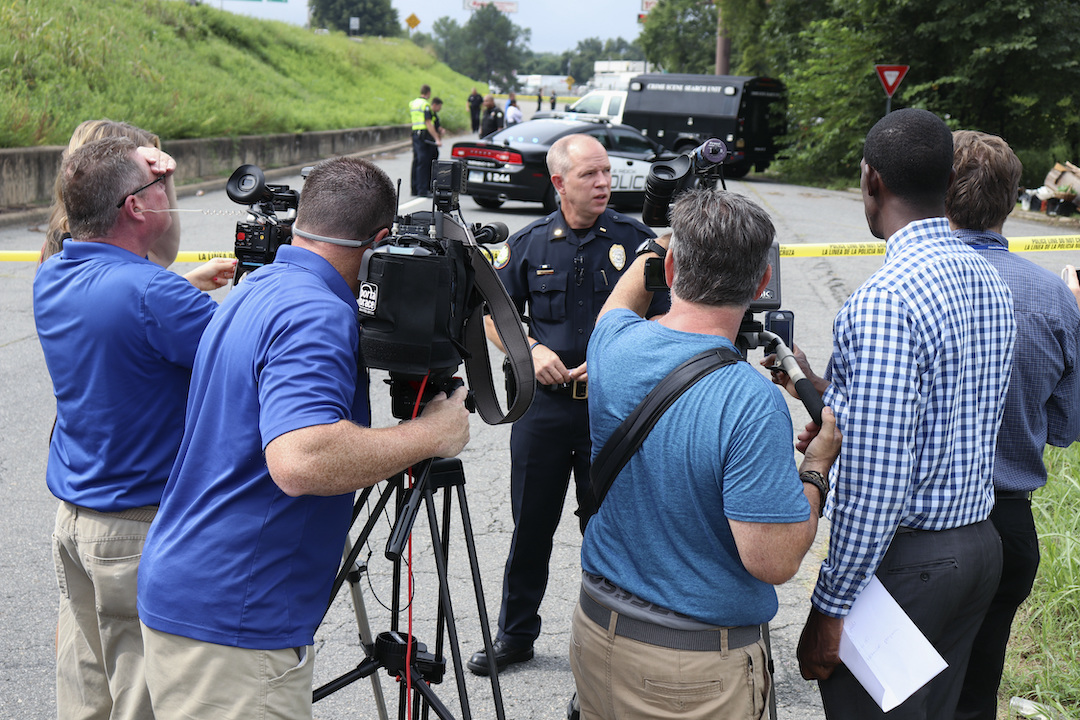Across the United States local journalists are attempting to reform their approach to covering crime, moving away from “If it bleeds, it leads” and toward explanatory and accountability reporting.
Newsrooms are implementing policies designed to encourage deep reporting on public safety trends. And, they are discouraging common journalism habits that can amplify false stereotypes, like rampant use of police mugshots, or relying on police press releases as the sole source of information for stories.
While this movement is still nascent, progress is visible.
First, news organizations got rid of their mugshot galleries. That move was underway in 2020, but accelerated after the public protests following the murder of George Floyd by a Minneapolis police officer. After that, many newsrooms adopted a higher threshold for running a mugshot at all.
At the same time, some news companies started entertaining requests to take down old content, much of it relating to crime stories that were reported after initial arrests were made, but never followed up on, even when the charges were reduced or dropped.
While all this was unfolding, the battle for local audiences evolved. Local newspapers continue to shrink as they struggle to find sustainable economic models. For-profit digital competitors like Axios moved into many markets. Local public radio news capacity expanded, and nonprofit startups also proliferated. Local TV news continues to attract viewers, but it faces a related set of threats. Consumers are leaving cable TV in favor of streaming and turning to mobile apps for local weather and traffic updates.
That volatility means that local newsrooms are eager to define relationships with their audiences that will distinguish them from their competitors. Every newsroom declares it wants to be the “trusted source” of news for the community. Many are rethinking their crime coverage, recognizing that the communities most affected by crime often feel revictimized by the media.
This is where newsrooms with strong leadership separate themselves from the pack. Going beyond those mostly cosmetic reforms is much harder for news companies because it requires the entire staff to rethink how it defines breaking news.
I know because I’ve coached more than 50 newsrooms through two pilot projects on transforming crime coverage here at Poynter. (We are currently accepting applications for 25 more newsrooms to participate.) These companies have come to see that most crime stories are the junk food of the daily news budget. Nobody wants to run them, but breaking the habit is incredibly difficult.
While each newsroom that I’ve helped has struggled in unique ways, I’ve noticed a handful of patterns at each step of the process.
Step 1: Why cover crime at all?
When I ask this question many journalists think I’m joking. I’m a former crime reporter. I get it. The marriage of the sensational crime story and the daily news report was cemented so long ago, it’s hard to imagine it could be different.
When I press, most journalists arrive at the language of “public safety,” meaning that journalists report on crime so that the public can “be safe.” That argument falls apart quickly when I press for specific connections between news reports on specific crimes and overall public safety. Of course there are exceptions, like when a serial predator is on the loose. But most stories about instances of crime do nothing to promote public safety.
The first step is to articulate a journalistic purpose that goes beyond, “It’s just interesting.” When newsrooms struggle with this step, it’s either because they have journalists on staff who have built their careers on traditional crime coverage or because the organization is addicted to the modest traffic spikes that come with crime stories, and the big peaks that come with the most sensational stories.
Step 2: Which crimes to cover?
Establishing guidelines about which crimes should be pursued or reported on is one of the first stumbling blocks for many newsrooms. For most newsrooms that haven’t gone through this program, it’s rare to have a written policy that helps reporters decide which crime stories to cover.
Mike Canan was the senior director of local media content at WCPO-TV in Cincinnati when he recognized that his crews were more likely to cover nonfatal shootings that were closer to the station. And they didn’t always follow up on those stories, which is particularly harmful when people are arrested but the charges are later dropped or reduced.
Canan, who teaches in our course, changed his newsroom’s approach. WCPO still sent crews to many shootings but only did stories when someone died, or when the shooting was in a high-profile location like a shopping mall, or when it involved a child or prominent person. WCPO also promised to follow up on every story it initially reported.
In Seattle, the journalists at KING-TV recognized the traditional approach to covering crime was flawed and stopped doing most of it before the station enrolled in the Poynter course in 2022. That was a bit of an overcorrection, news director Julie Wolfe told me. Turns out that it’s easier to just quit covering crime than it is to reform the reporting approach.
“We wanted to go through the program to create not just the idea of who we want to be, but the workflow and the process to make sure that it lives beyond those of us who are here now,” she said.
KING’s policies set a high bar, discouraging stories reported only from police sources, Wolfe said. Field crews expressed concerns that they wouldn’t always be able to hit that standard. Wolfe said that after discussing it, they decided to keep the policy in place.
“We are not going to lower the bar so we can easily reach it every day,” she said. “Some days we might fall short. … Maybe sometimes it’s day two when we fulfill the commitment.”
In San Diego, KPBS realized that the traditional public radio approach (ignoring most crime because commercial media covers it so much) was inadequate because the newsroom didn’t have a clear vision of what they should cover.
After taking the course, an internal newsroom committee drafted a set of guidelines for journalists creating stories for the shows, podcasts and the website. Digital editor Elma González Lima Brandão said during an on-air interview that the station consulted with its listeners to find out what they wanted to know.
“Communicating what we will and will not cover gives our audiences a clearer picture of who we are as a news organization and internally allows us to focus resources in more impactful ways,” said Terence Shepherd, KPBS news director.
Step 3: Getting data, understanding trends, informing the public
Prior to the pandemic, crime rates across America had been declining for 30 years. That trend still holds mostly true, although many cities and states saw increases in 2020. Even so, crime rates continue to be much lower than they were in the late 1980s and early 1990s.
And yet, almost every year when they are polled, most Americans believe crime is getting worse. Why is this? Two reasons.
First, the data is both slow and flawed. By the time the FBI releases its annual report, the data is almost a year old. Although there was a violent crime increase in some cities in 2020, it was already starting to fall in some places by the time the FBI stats were released in late 2021. Just over half of law enforcement agencies report their crime stats to the Justice Department. And there are no audits at all to determine if the reports are accurate.
Second, the amount of space the news media devotes to crime tends to stay the same whether crime is rising or falling. As a result, news consumers get the same diet of crime stories, regardless of the trends. Their conclusions, although wrong, are not unwarranted.
Solving this problem is not easy. This year we’ve expanded our program to include a section on data, taught by Ted Gest, a veteran reporter and the president of the association of Criminal Justice Journalists. We’ve also added a section on daily techniques for scrutinizing law enforcement agencies.
How change happens
Every one of the 44 newsrooms that completed the program in 2022 came up with its own custom plan, rooted in the community it serves, the resources it has and the mission of its newsroom.
Most of the newsrooms rolled out their new policies and strategies step by step. Almost every participant said it took longer than they planned. Some newsrooms discovered specific sticking points: for instance, persuading weekend staff to change their story choices. (As a result, we’ve added a session on training and implementation.)
Because this work involves redefining how journalists work with police, it’s common for those relationships to become strained. That’s what happened ABC15 in Phoenix, which already had a robust history of investigating law enforcement.
“After our transformation, some police agencies criticized our coverage and refused to work with us even on ‘positive’ stories. Some of those rifts were mended as we explained why KNXV covers public safety differently,” said Melissa Blasius, manager of investigative content. “We also learned not to focus on the few stories we didn’t get. Instead, we concentrate on providing the information that is most valuable to our entire community.”
Poynter’s Transforming Crime course requires newsrooms to assemble a team to work on the project of rethinking public safety coverage. KING-TV’s Wolfe advised newsrooms to assemble a team that includes representatives from across the newsrooms, including field crews, producers and digital staff.
“When we presented (the new policy) to the teams, it was accepted because it was from their people,” she said. “It felt like we had buy-in.”
Some of the newsrooms from 2022 have even asked to repeat the course. But we’re going to give priority to first-timers. Applications are open for the 25 slots in the 2023 installment of Transforming Crime Reporting into Public Safety Journalism through April 21. The course tuition is $1,000 per newsroom, thanks to funding from The MacArthur Foundation and The Annie E. Casey Foundation. We’re admitting newsrooms on a rolling basis, meaning there is an advantage in applying early.
This article has been corrected to note that KPBS is based in San Diego.








As a long-time public safety reporter for a small newspaper, we’ve always covered most of our crime beat through the courts. One of the things that frustrates me about the coverage across the country is that there are lots of outlets that will publish an arrest, but very few who will devote the resources to finding out what happens after the arrest. When we report an arrest, we accept the responsibility to follow that person through the court system to sentencing and sometimes beyond.